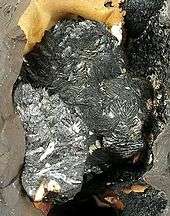Groutite
| Groutite | |
|---|---|
|
Groutite from the Black Water Mine, Black Mesa Basin, Apache County, Arizona, USA | |
| General | |
| Category | Oxide mineral |
| Formula (repeating unit) | Mn3+O(OH) |
| Strunz classification | 4.FD.10 |
| Crystal system | Orthorhombic |
| Crystal class |
Dipyramidal (mmm) H-M symbol: (2/m 2/m 2/m) |
| Space group | Pbnm |
| Unit cell |
a = 4.56, b = 10.7 c = 2.87 [Å]; Z = 4 |
| Identification | |
| Color | Jet-black |
| Crystal habit | Wedge or lens-shaped crystals; acicular, striated prisms |
| Twinning | Reported, unknown law |
| Cleavage | Perfect on {010}; less perfect on {100} |
| Fracture | Uneven |
| Tenacity | Brittle |
| Mohs scale hardness | 3.5 - 4.0 |
| Luster | Brilliant submetallic to adamantine |
| Streak | Dark brown |
| Diaphaneity | Opaque |
| Specific gravity | 4.144 |
| Optical properties | Biaxial (+) |
| Refractive index | nα = 2.100 - 2.200 nγ = 2.100 |
| Pleochroism | Very strong; X = very dark brown to black; Y = yellowish brown |
| 2V angle | Measured: 40° to 50° |
| References | [1][2][3] |
Groutite is a manganese oxide mineral with formula Mn3+O(OH). It is a member of the diaspore group and is trimorphous with manganite and feitknechtite. It forms lustrous black crystals in the orthorhombic system.

Cluster of groutite crystals with kaolinite filling half of a vug in a manganese nodule (size: 3.5 x 3 cm) from the Emilie Mine, Peine, Lower Saxony, Germany
It occurs in weathered banded iron formations, metamorphosed manganese ore bodies and hydrothermal ore environments.[1] It was first described in 1945 for an occurrence in the Mahnomen mine, Cuyuna Range, Crow Wing County, Minnesota and named for petrologist Frank Fitch Grout (1880–1958), of the University of Minnesota.[3]
References
This article is issued from Wikipedia - version of the 11/16/2016. The text is available under the Creative Commons Attribution/Share Alike but additional terms may apply for the media files.
